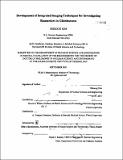| dc.contributor.advisor | Bruce R. Rosen and A. Gregory Sorensen. | en_US |
| dc.contributor.author | Kim, Heisoog | en_US |
| dc.contributor.other | Massachusetts Institute of Technology. Dept. of Nuclear Science and Engineering. | en_US |
| dc.date.accessioned | 2013-02-14T15:17:09Z | |
| dc.date.available | 2013-02-14T15:17:09Z | |
| dc.date.copyright | 2011 | en_US |
| dc.date.issued | 2011 | en_US |
| dc.identifier.uri | http://hdl.handle.net/1721.1/76916 | |
| dc.description | Thesis (Ph. D.)--Massachusetts Institute of Technology, Dept. of Nuclear Science and Engineering, 2011. | en_US |
| dc.description | Cataloged from PDF version of thesis. Page 125 blank. | en_US |
| dc.description | Includes bibliographical references. | en_US |
| dc.description.abstract | Cancer is a diverse disease with many manifestations. Various imaging modalities including magnetic resonance imaging (MRI) and positron emission tomography (PET) have been used to study human cancer. In this study, we developed integrated imaging techniques using advanced MR and PET to investigate potential biomarkers in glioblastoma (GBM). First, we applied proton magnetic resonance spectroscopy to assess the therapeutic effects of the new antiangiogenic drug (cedianib) on GBM. By evaluating changes in the levels of metabolites predominant in GBM during the treatment, we observed an antitumor response in GBM after one month. Notably, the index of the ratio of primary metabolites, NAA/Cho, in tumor strongly predicted 6-month overall survival; these data therefore suggest that NAA/Cho is the MRS-detectable biomarker that relates to tumor angiogenesis. Second, a simultaneous BOLD-ASL technique was investigated to measure the relative cerebral metabolic rate of oxygen (CMRO₂) in hyperoxia (i.e., CMRO₂/CMRO₂/₀) in GBM. Renewed interest in tumor metabolism, particularly in GBM, has recently prompted a re-examination of the Warburg effect. Our data have revealed that oxygen-induced CMRO₂ in tumor showed significant increase, supporting recent hypotheses on the preserved integrity of oxidative pathways in glycolytically active tumors. These data also propose a second remarkable biomarker for detecting tumor oxidative metabolic changes. Finally, and most importantly, we extended our earlier findings to explore the correlation between changes in oxidative metabolism and hypoxia level in GBM patients undergoing a multi-therapy treatment protocol by acquiring simultaneous MRI-PET data using our novel dual-modality MRPET imaging system. We observed an increase in relative CMRO₂ in regions showing high-level uptake of our ¹⁸F-MISO probe in pre-treated tumor, and a subsequent large reduction in both values with tumor regression following treatment. The consistency between tumor oxidative physiology and hypoxia assessed by our novel integrated imaging approach will be a good biomarker for detecting oxidative changes with therapeutic effects in gliomas. Overall, our integrated imaging methods offer great potential to move from the preliminary biomarker stage to later stages with more clearly established utility. With further investigation, these imaging tools could contribute in significant ways to the ongoing effort to reduce morbidity and mortality in cancer. | en_US |
| dc.description.statementofresponsibility | by Heisoog Kim. | en_US |
| dc.format.extent | 125 p. | en_US |
| dc.language.iso | eng | en_US |
| dc.publisher | Massachusetts Institute of Technology | en_US |
| dc.rights | M.I.T. theses are protected by
copyright. They may be viewed from this source for any purpose, but
reproduction or distribution in any format is prohibited without written
permission. See provided URL for inquiries about permission. | en_US |
| dc.rights.uri | http://dspace.mit.edu/handle/1721.1/7582 | en_US |
| dc.subject | Nuclear Science and Engineering. | en_US |
| dc.title | Development of integrated imaging techniques for investigating biomarkers in glioblastoma | en_US |
| dc.type | Thesis | en_US |
| dc.description.degree | Ph.D. | en_US |
| dc.contributor.department | Massachusetts Institute of Technology. Department of Nuclear Science and Engineering | |
| dc.identifier.oclc | 824170569 | en_US |
